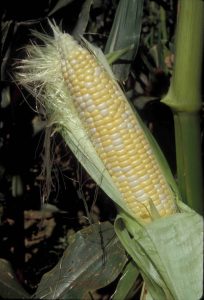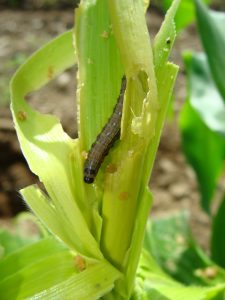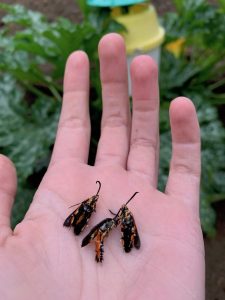Sweet Corn IPM Newsletter No. 2 – July 10, 2020

Sweet Corn IPM Newsletter No. 2 – July 10, 2020
Click on photos to enlarge.
CORN EARWORM, FALL ARMYWORM THREATEN EARLY CORN
Early-Planted Fields Now Silking May Require Protection
SITUATION
Recent warm weather and rain showers have advanced corn development rapidly in much of the state. Earliest planted corn with plastic mulch or rowcovers in southern Maine is starting to silk. Both corn earworm and fall armyworm have arrived just in time to threaten this early silking corn, and European corn borer is active in younger corn. While the greatest threat now is to silking corn, both European corn borer and fall armyworm can cause significant injury to younger plant stages as well. Warm temperatures, predicted for the days ahead, will likely increase insect activity, so growers with silking corn should consider protecting it.
European corn borer:

Larval feeding injury was over the 15% control threshold for pre-tassel corn in Biddeford, Poland Spring, and Sabattus. Sprays during the pre-tassel stage, when both moths and larvae are present, can control larvae before they move into the stalks and ears where they will be protected. Once corn reaches the silk stage, sprays may be based on the number of moths caught in pheromone traps. Moths will lay eggs on flag leaves of silking corn, and the larvae can move into the ears without leaving visible feeding injury. If more than five moths are caught during a week in silking corn, a spray is recommended. However, no European corn borer trap counts were over the spray threshold for silking corn this week.
Corn earworm:

We caught earworm moths in most locations throughout the state this week. These moths will lay eggs on fresh silking corn, so early fields with silking corn should be protected. The recommended frequency of sprays depends on the number of moths present at a site. More moths will require more frequent sprays to provide good control. A six-day spray interval for silking corn was recommended in Bowdoinham, New Gloucester and Sabattus. A five-day spray interval was recommended for a silking field in Lewiston this week.
Fall armyworm:

The first moths were caught in pheromone traps this week, creating a threat to silking corn, although most captures were below the three moth threshold for silking corn. A small amount of larval feeding damage was also noticed on pre-tassel corn, suggesting that this will become a more widespread problem soon. A spray to protect silking corn against fall armyworm was recommended in Poland Spring. This site is not under a spray interval for corn earworm yet, so a spray specifically for fall armyworm is warranted.
Squash vine borer

moths are being caught in high numbers in New Hampshire this week. We have set up traps at several locations, and will have data from them next week. However, growers in southern Maine should scout squash and pumpkin fields for squash vine borer feeding at the base of the plants and/or wilting vines now, and apply appropriate control if damage is found. Squash vine borer moths are black and orange and resemble wasps. They lay their eggs at the base of squash plants. The larvae bore into the base of the plants, causing vines to wilt and collapse. See the 2020-2021 New England Vegetable Management Guide for control options.
Sincerely,
David T. Handley
Vegetable and Small Fruit Specialist
Highmoor Farm UMaine Extension Diagnostic
P.O. Box 179 Research Lab, Pest Mgmt. Unit
52 U.S. Route 202 17 Godfrey Drive
Monmouth, ME 04259 Orono, ME 04473
207.933.2100 1.800.287.0279
| Location | CEW
Moths |
ECB
Moths |
FAW
Moths |
%Feeding
Damage |
Recommendations / Comments |
|---|---|---|---|---|---|
| Biddeford | 0 | 0 | 2 | 22% | One spray for ECB, FAW on pre-tassel corn |
| Bowdoinham | 2 | 1 | 0 | 8% | 6-day spray interval for silking corn |
| Cape Elizabeth I | 0 | 0 | 0 | 1% | No spray recommended |
| Dayton I | 1 | 0 | 0 | 1% | No spray recommended |
| Farmington | 0 | 0 | 0 | 2% | No spray recommended |
| Lewiston | 0 | 4 | 0 | 4% | No spray recommended |
| Lewiston II | 4 | 0 | 0 | 0% | 5-day spray interval for all silking corn |
| Monmouth | 1 | 0 | 1 | 4% | No spray recommended |
| New Gloucester | 2 | 0 | 2 | 0% | 6-day spray interval for all silking corn |
| Oxford | 0 | 0 | 1 | 1% | No spray recommended |
| Poland Spring | 0 | 3 | 4 | 30% | One spray for ECB & FAW on pre-tassel – silking corn |
| Sabattus | 2 | 0 | 0 | 16% | 6-day spray interval for silking corn, 1 spray for ECB |
| Wayne | 0 | 0 | 0 | 2% | No spray recommended |
| Wells I | 1 | 0 | 0 | 3% | No spray recommended |
| Wells II | 0 | 0 | 1 | 3% | No spray recommended |
CEW: Corn earworm (Only fresh silking corn should be sprayed for this insect.)
ECB: European corn borer
FAW: Fall armyworm
| Moths caught per week | Moths caught per night | Spray interval |
|---|---|---|
| 0.0 to 1.4 | 0.0 to 0.2 | No spray |
| 1.5 to 3.5 | 0.3 to 0.5 | Spray every 6 days |
| 3.6 to 7.0 | 0.6 to 1.0 | Spray every 5 days |
| 7.1 to 91 | 1.1 to 13.0 | Spray every 4 days |
| More than 91 | More than 13 | Spray every 3 days |
Thresholds apply only to corn with exposed fresh silk. Lengthen spray intervals by one day if maximum daily temperature is less than 80°F.
European Corn Borer Thresholds:
Whorl stage: 30% or more of plants scouted show injury.
Pre-tassel-silk: 15% or more of plants scouted show injury.
Silk: 5 or more moths caught in pheromone traps in one week.
IPM Web Pages:
Integrated Pest Management in Maine
Integrated Pest Management Data Visualization Tool
UMass Cooperative Extension Website
Where brand names or company names are used, it is for the reader’s information. No endorsement is implied nor is any discrimination intended against other products with similar ingredients. Always consult product labels for rates, application instructions and safety precautions. Users of these products assume all associated risks.
The University of Maine is an equal opportunity/affirmative action institution.
